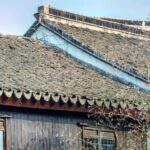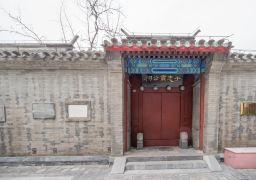Yantou Village is located on the west bank of the middle reaches of the Nanxi River, between Cangpo and Furong, 38 kilometers away from Yongjia County. It is named Yantou because it is situated at the head of the three rocks of Furong. The main entrance of Yantou Village is the North Gate, known as the ‘Gate of Benevolence’. Inside the gate, to the west of the main street, stands the Jin Clan Ancestral Hall, facing south. In front of the ancestral hall is the Jinshi Archway. The Jinshi Archway is one of the most magnificent among similar structures along the Nanxi River. Across the street from the ancestral hall is the stone Xie’s Chastity Archway, built in the thirteenth year of the Jiaqing era. The Gate of Benevolence, the Jin Clan Ancestral Hall, the Chastity Archway, and the Jinshi Archway form the ceremonial center of Yantou.
The east gate of Yantou Village is called the ‘Gate of Dedication’, and there is a street named ‘Heng Street’ that runs from the Gate of Dedication to the west across the village. The western section of Heng Street is home to two straight streets; one is Junshui Street to the west, and the other is the Central Street. These streets are the main thoroughfares of Yantou Village, with narrow and straight alleys between them, all pointing towards the nearby Yu Mountain, known as ‘Arrows’. In the past, there were seven large residences with three sections and two courtyards each, arranged from south to north between Jinshi Street, Central Street, and Junshui Street. The interval between each central axis is 48.3 meters, and the arrows are the alleys between them. The distance between each street is 55 meters, which is exactly the total depth of the large residences. All residential buildings in the village face east, with the main doors on the west side of these streets and the back doors on the east side, while water channels are on the east side. The large complex of residences built under the supervision of Jin Yongpu is meticulously planned and grand in scale, occupying more than half of the village’s area. In the first year of the Tongzhi era, due to the Taiping Rebellion and clan disputes, a large number of houses were burned down, including these 21 buildings. Now, the architectural remains of nine of them can be seen on Junshui Street, Central Street, Guihua Street, and Huaqian Street. The six buildings on Junshui Street have now become alleys, with the pathways in the courtyards still relatively intact. In addition, on the water conservancy dam at the eastern edge of the village, there is the village’s initial commercial street: Lishui Street, with the Tahu Temple Scenic Area to the south of it. At the southern end of Central Street in Yantou Village, there is also the Shuitin Ancestral Hall created by Jin Yongpu, each with its own attractions. The entire text is open all year round from 08:00 to 17:30.Yantou Ancient Village
Yantou Village is located on the west bank of the middle reaches of the Nanxi River, between Cangpo [...]









